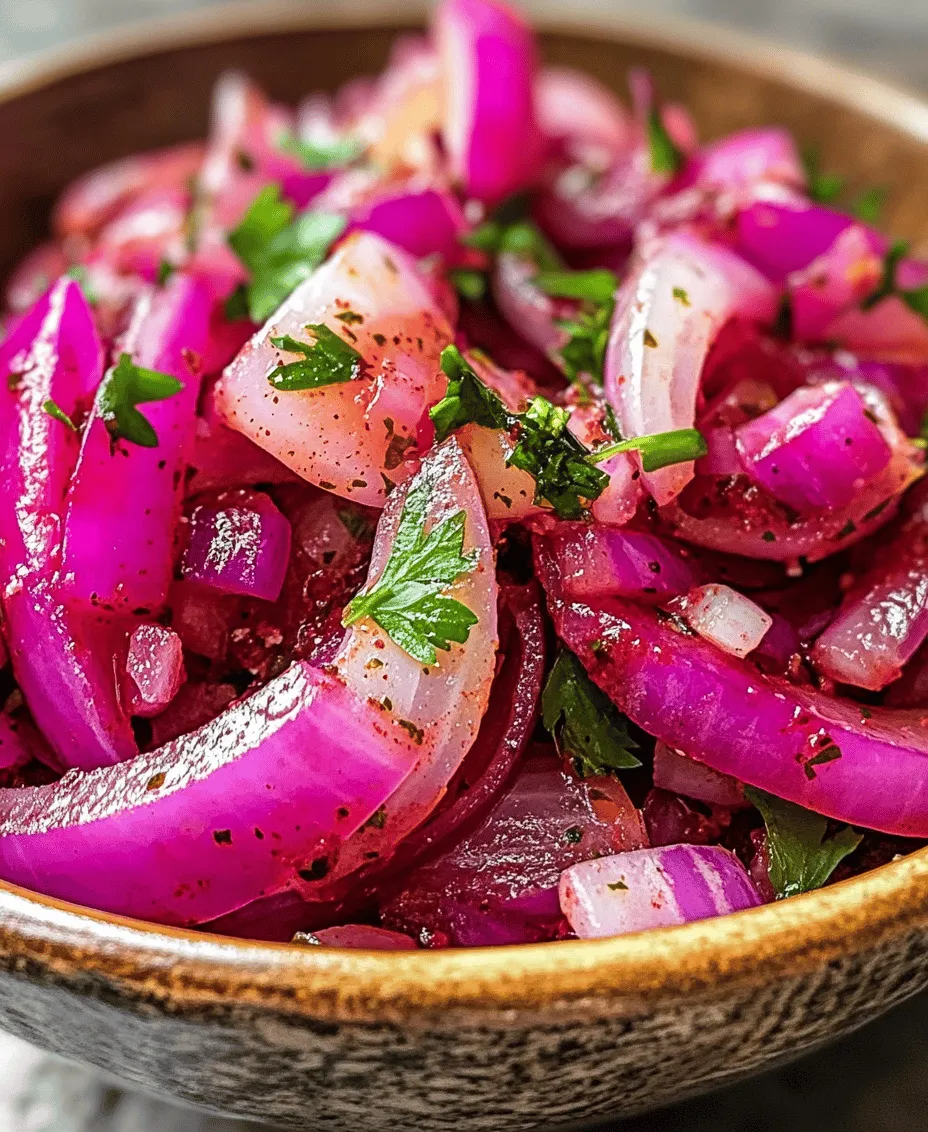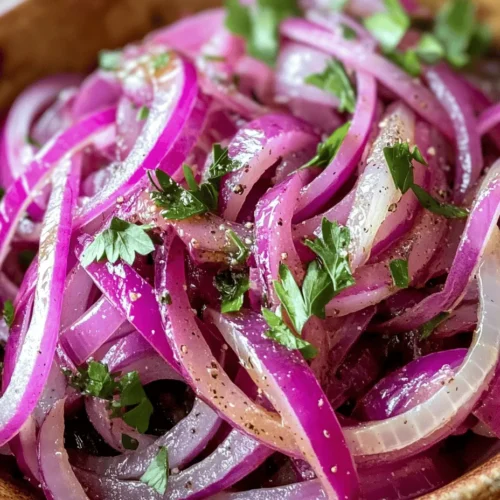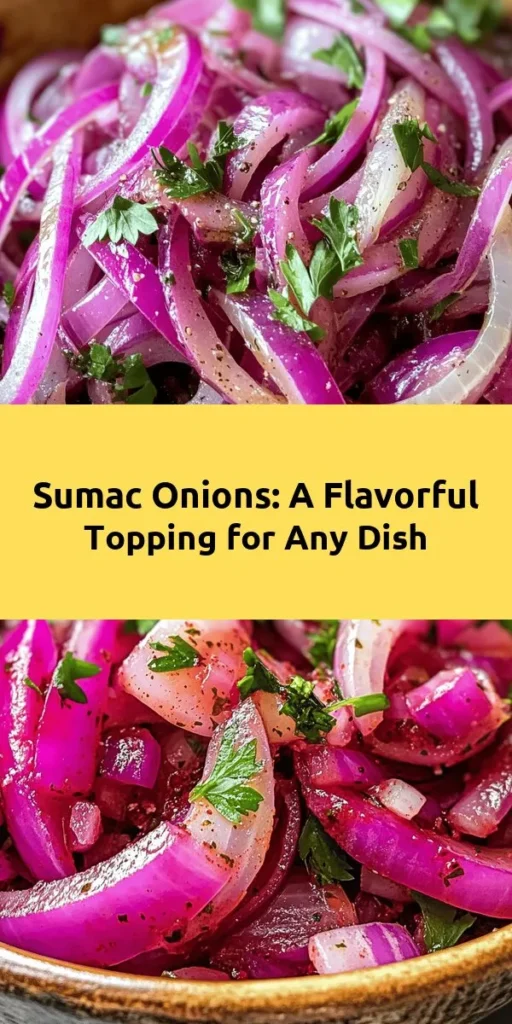Introduction
Sumac Onions Delight is a vibrant and zesty dish that brings together the unique flavors of sumac and fresh onions, transforming simple ingredients into a culinary experience. This dish has its roots in Middle Eastern cuisine, where sumac is often used to enhance the flavors of various dishes. It showcases the beauty of using fresh, high-quality ingredients that not only elevate the taste but also contribute to a healthier meal. Sumac Onions Delight can be served as a side dish, a topping for grilled meats, or even as a component in salads, lending its tangy flavor profile to a variety of culinary creations.
At the heart of this recipe is sumac, a spice that has been cherished for centuries across different cultures. Its vibrant red hue and tart flavor make it a popular choice in many traditional dishes, often used as a seasoning to balance the richness of meats and the freshness of vegetables. This article delves into the significance of sumac, the versatility of onions, and the importance of selecting fresh ingredients to craft this delightful dish.
Understanding Sumac
Sumac, derived from the dried and ground berries of the Rhus plant, boasts a unique flavor profile that is both tangy and slightly fruity. It is a staple in Middle Eastern cooking and has found its way into various global cuisines thanks to its versatile nature. The tartness of sumac is often likened to that of lemon, making it an excellent choice for adding brightness to dishes without the need for citrus. In Sumac Onions Delight, this spice plays a pivotal role in enhancing the natural flavors of the onions.
Beyond its flavor, sumac also offers several nutritional benefits. It is rich in antioxidants, which help combat oxidative stress in the body, and has been associated with anti-inflammatory properties. Additionally, sumac contains beneficial compounds that may aid in digestion and support heart health. Its culinary history stretches back to ancient times, where it was not only used as a seasoning but also as a natural remedy in various cultures. Today, sumac is celebrated for its flavor, health benefits, and cultural significance, making it a must-have in any spice cabinet.
The Versatility of Onions
Onions are a foundational ingredient in kitchens around the world, known for their ability to enhance the flavor of a wide array of dishes. There are several types of onions, including yellow, white, and red, each offering distinct flavors and culinary uses. Yellow onions are often used for their balanced sweetness and versatility in cooking, while white onions are typically sharper and more pungent. However, for our Sumac Onions Delight, red onions are the preferred choice.
Red onions are favored for their mild and sweet flavor, which pairs beautifully with the tangy sumac. They add a pop of color to the dish, making it visually appealing, and their crisp texture provides a satisfying crunch. In addition to their culinary uses, onions boast numerous health benefits. They are rich in vitamins C and B6, minerals like manganese and potassium, and antioxidants, particularly quercetin, which may help reduce inflammation and support heart health.
The combination of the nutritional value of onions and the unique flavor of sumac creates a dish that is not only delicious but also beneficial for overall health. This makes Sumac Onions Delight an excellent choice for anyone looking to incorporate more fresh ingredients into their meals.
Ingredients Breakdown
To prepare Sumac Onions Delight, you will need the following ingredients, each playing a crucial role in the overall flavor and texture of the dish:
Red Onions: Selection and Preparation
When choosing red onions, look for bulbs that are firm to the touch, with a smooth, papery skin. Avoid any onions that are soft, sprouting, or have blemishes, as these may indicate spoilage. Once you have selected the finest red onions, the preparation is simple. Begin by peeling off the outer skin, then slice the onions thinly to showcase their natural sweetness and crispness. The thin slices will allow the flavors of the sumac and other ingredients to penetrate the onions, creating a delightful taste experience.
Olive Oil: Types and Health Benefits
Olive oil is a staple in Mediterranean cooking and is known for its heart-healthy properties. When selecting olive oil for this recipe, opt for extra virgin olive oil, which is made from the first cold pressing of olives and retains the most flavor and nutrients. Extra virgin olive oil is rich in monounsaturated fats, which can help reduce bad cholesterol levels and improve heart health. Additionally, it contains antioxidants that contribute to overall wellness. Drizzling high-quality olive oil over the onions enhances their flavor, making each bite even more delicious.
Sumac: How to Choose Quality Sumac
To achieve the best flavor in your Sumac Onions Delight, it is essential to choose high-quality sumac. Look for sumac that is bright red in color, as this indicates freshness and potency. The spice should have a fruity, tart aroma without any musty or off-putting smells. Sumac can be found in specialty spice shops, Middle Eastern markets, or online. When storing sumac, keep it in a cool, dark place in an airtight container to preserve its flavor and freshness.
Sea Salt: Importance of Using High-Quality Salt
The right salt can elevate the flavors of your dish, and in this recipe, high-quality sea salt is recommended. Sea salt is minimally processed and retains essential minerals that can enhance the taste of the onions and balance the tartness of the sumac. When seasoning your dish, start with a small amount of sea salt, as the flavor can be quite potent. You can always adjust the seasoning to your liking as you prepare the dish.
Honey vs. Maple Syrup: Taste and Dietary Considerations
For this recipe, you can choose between honey and maple syrup to add a hint of sweetness to balance the tanginess of the sumac. Honey offers a floral sweetness that complements the dish beautifully, while maple syrup provides a deeper, more complex flavor. Consider dietary preferences when making your choice; honey is not vegan, while maple syrup is plant-based. Both options provide health benefits, with honey containing antibacterial properties and maple syrup being rich in antioxidants.
Fresh Lemon Juice: Benefits and Freshness Tips
Fresh lemon juice is the final touch that brightens the dish and adds a citrusy zing. When selecting lemons, choose those that feel heavy for their size and have a bright, smooth skin. The juice of freshly squeezed lemons is packed with vitamin C, which supports the immune system and adds a refreshing taste to the Sumac Onions Delight. To extract the most juice, roll the lemon on the countertop before cutting it in half. This technique breaks down the fruit’s membranes and allows for easier juicing.
By carefully selecting and preparing each ingredient, you set the foundation for a truly delightful dish that showcases the flavors of sumac and onions. As you continue through the recipe, these fresh elements will come together to create a harmonious balance of flavors, inviting you and your guests to enjoy a taste of Middle Eastern culinary heritage.

Fresh Parsley: The Finishing Touch for Flavor and Presentation
Fresh parsley is the perfect herb to finish your Sumac Onions Delight. Its vibrant green color not only enhances the dish’s visual appeal but also adds a bright, fresh flavor that balances the tanginess of sumac and the sweetness of the onions. When using parsley, opt for fresh, flat-leaf parsley as it has a more robust flavor compared to curly parsley. Chop it finely and sprinkle it over the marinated onions just before serving to elevate the dish’s presentation and taste.
Step-by-Step Instructions
Preparing the Onions: Importance of Salting
1. Slice the Onions: Begin by peeling and thinly slicing 2 large red onions. The slices should be about 1/8-inch thick to ensure they marinate evenly and retain a pleasant crunch.
2. Salt the Onions: Place the sliced onions in a bowl and sprinkle them generously with salt (about 1 teaspoon). Toss the onions gently to ensure they’re evenly coated. Allow them to sit for 15 to 20 minutes. This process draws out excess moisture, softens the onions slightly, and enhances their flavor. Salting is crucial as it also helps to mellow the onions’ sharpness, making them more palatable.
Marinating Process: How It Enhances Flavor
3. Prepare the Marinade: In a separate bowl, combine the juice of 2 large lemons, 2 tablespoons of extra-virgin olive oil, and 2 tablespoons of ground sumac. Mix well until all ingredients are thoroughly combined.
4. Combine Onions and Marinade: After the onions have been salted and drained, rinse them under cold water to remove excess salt and moisture. Pat them dry with a paper towel. Add the rinsed onions to the marinade, ensuring they are fully coated. Cover the bowl with plastic wrap or transfer the mixture to a glass jar with a tight-fitting lid.
5. Let It Marinate: Allow the onions to marinate for at least 30 minutes at room temperature or up to 2 hours in the refrigerator. The longer the onions sit in the marinade, the more flavorful they will become. This marinating process not only infuses the onions with the tangy, zesty flavors of lemon and sumac but also softens them, making them easier to eat.
Serving Suggestions: Balancing Flavors with Various Dishes
Sumac Onions Delight can be served in numerous ways, making it a versatile addition to your culinary repertoire. Here are some ideas for how to incorporate this delightful dish into your meals:
– As a Side Dish: Serve the marinated onions alongside grilled meats, such as chicken, lamb, or beef. Their tangy flavor pairs beautifully with the rich, smoky notes of grilled proteins, enhancing the overall dining experience.
– In Wraps and Sandwiches: Use Sumac Onions Delight as a condiment in wraps and sandwiches. The acidity of the marinated onions cuts through the richness of meats and spreads, adding a refreshing touch. They work particularly well in Middle Eastern-style wraps, adding depth and character to falafel or shawarma.
– In Salads: Top your salads with a generous helping of sumac onions. They can elevate a simple green salad, grain bowl, or even a Mediterranean chickpea salad, providing a burst of flavor and texture.
Flavor Pairings and Serving Suggestions
Pairing Sumac Onions Delight with other dishes can enhance the overall meal experience. Here are some recommendations:
– Grilled Vegetables: The tangy notes of the onions complement the natural sweetness of grilled vegetables such as bell peppers, zucchini, and eggplant. Toss your vegetables in a bit of olive oil, season with salt, and grill until tender.
– Rice and Grain Dishes: Incorporate the marinated onions into pilafs or grain bowls made with quinoa, couscous, or rice. The dish will gain a refreshing zing that balances hearty grains.
– Cheese Platters: For a more casual presentation, serve Sumac Onions Delight as part of a cheese platter. The tartness of the onions pairs well with creamy cheeses like goat cheese or feta, providing a delightful contrast.
Nutritional Information
Understanding the nutritional value of Sumac Onions Delight can help you appreciate its health benefits. Here’s a breakdown per serving (approximately 1/4 cup):
– Calories: 45
– Carbohydrates: 6g
– Fiber: 1g
– Protein: 1g
– Fat: 2g
– Vitamin C: 15% of the Daily Value (DV)
– Iron: 5% of the DV
Health Benefits of Consuming This Dish Regularly
– Rich in Antioxidants: Sumac is known for its high antioxidant content, which can help combat oxidative stress in the body.
– Digestive Aid: The acidity of lemon juice aids in digestion and can contribute to a healthy gut.
– Low-Calorie Flavor Booster: Instead of reaching for high-calorie dressings or condiments, Sumac Onions Delight provides a flavorful alternative that enhances meals without adding excessive calories.
Considerations for Dietary Restrictions (Vegan Option)
This recipe is naturally vegan, making it an excellent choice for those following plant-based diets. It’s also gluten-free and can be enjoyed by individuals with various dietary restrictions.
Cultural Variations and Alternatives
Sumac Onions Delight has roots in Middle Eastern cuisine, where similar dishes are enjoyed across different cultures. Here are a few variations and alternatives:
– Persian Shallot Salad: In Persian cuisine, shallots are often used instead of onions, marinated in similar spices and served with grilled meats.
– Turkish Onion Salad: This variation may incorporate additional spices like paprika or cumin, adding layers of flavor.
– Alternative Ingredients: If you’re looking to adapt the recipe for different tastes or dietary needs, consider using red wine vinegar instead of lemon juice for a different acidity profile, or substituting different herbs like mint or cilantro for parsley.
– Occasion Adaptation: For festive occasions, consider adding pomegranate seeds or chopped nuts to the Sumac Onions Delight for added texture and a pop of color, making it a special dish for gatherings.
Conclusion
In summary, Sumac Onions Delight is a vibrant, tangy, and refreshing dish that can elevate any meal. Its combination of sweet, salty, and sour flavors makes it an extraordinary addition to a variety of dishes. By experimenting with this recipe and incorporating it into different meals, you can discover new flavor combinations and enjoy the health benefits of fresh ingredients.
As you create this dish, remember to embrace the versatility of fresh, flavorful ingredients in your home cooking. Whether served as a side, condiment, or incorporated into a salad, Sumac Onions Delight is sure to impress. Don’t be afraid to make it your own—add your favorite herbs, adjust the acidity, or experiment with the serving style. Enjoy the process of cooking and the delightful flavors that come from it!



